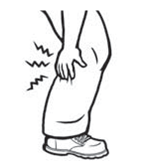Heat
Heat-related Illnesses and First Aid

Heat stroke, the most serious form of heat-related illness, happens when the body becomes unable to regulate its core temperature. Sweating stops and the body can no longer rid itself of excess heat. Signs include confusion, loss of consciousness, and seizures. Heat stroke is a medical emergency that may result in death! Call 911 immediately.

Heat exhaustion is the body's response to loss of water and salt from heavy sweating. Signs include headache, nausea, dizziness, weakness, irritability, thirst, and heavy sweating.

Heat cramps are caused by the loss of body salts and fluid during sweating. Low salt levels in muscles cause painful cramps. Tired muscles—those used for performing the work—are usually the ones most affected by cramps. Cramps may occur during or after working hours.
Heat rash, also known as prickly heat, is skin irritation caused by sweat that does not evaporate from the skin. Heat rash is the most common problem in hot work environments.
The chart below shows symptoms and first aid measures to take if a worker shows signs of a heat-related illness.
| Illness | Symptoms | First Aid* |
|---|---|---|
| Heat stroke |
|
While waiting for help:
|
| Heat exhaustion |
|
|
| Heat cramps |
|
|
| Heat rash |
|
|
| * Remember, if you are not a medical professional, use this information as a guide only to help workers in need. | ||
For more information about heat-related illnesses:
- OSHA Campaign to Prevent Heat Illness in Outdoor Workers
- OSHA Technical Manual (OTM) Chapter – Heat Stress. OSHA Directive TED 01-00-015 [TED 1-0.15A], (September 15, 2017). Includes useful sections on heat illness, prevention programs, assessment and screening for heat stress in the workplace.
- Heat Illness. National Institutes of Health, Medline Plus. Includes information in multiple languages.
- Heat: A Major Killer. National Oceanic and Atmospheric Administration (NOAA), National Weather Service. Links to landing page with NWS's heat index description and chart.
- Heat Stress and Strain: TLV® Physical Agents 7th Edition Documentation. Summarizes the scientific data used by the American Conference of Government Industrial Hygienists (ACGIH) used to derive its threshold limit value (TLV) for heat exposure.

